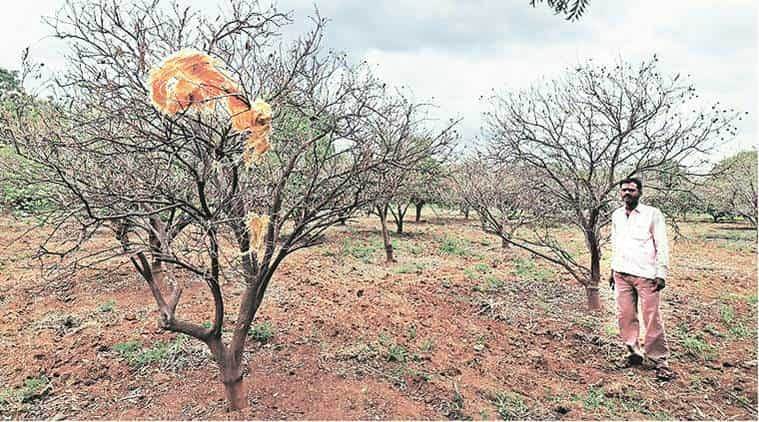- India
- International
After drought, Marathwada’s farmers hit by untimely rain
Marathwada’s eight districts, which bore the brunt of acute water scarcity through the first seven months of 2019, are now worst affected by the latest floods, with lakhs of acres of standing crop, including soyabean, cotton and bajra, washed out.
 Rain over nearly two weeks before Diwali damaged standing crop on 54.22 lakh hectares across the state. File
Rain over nearly two weeks before Diwali damaged standing crop on 54.22 lakh hectares across the state. File
Exactly a year since the Maharashtra government declared an early drought in 151 talukas after a poor monsoon, torrential rain over nearly two weeks before Diwali has damaged standing crop on 54.22 lakh hectares of farmland across the state. Almost the entire state is affected, with officials in 325 talukas now receiving urgent requests to assess the crop damage so as to announce relief measures.
Marathwada’s eight districts, which bore the brunt of acute water scarcity through the first seven months of 2019, are now worst affected by the latest floods, with lakhs of acres of standing crop, including soyabean, cotton and bajra, washed out.
“There is nobody in our village and nearby areas who is not affected. Every single farmer has suffered damage and complete destruction on one or two acres of land,” said Shrikant Gadale, a farmer in Beed’s Kaij taluka, where moisture stress in August had already led farmers to anticipate only about 50 per cent of average yield for their soyabean and cotton. “Now that too has been destroyed,” said Gadale, a resident of Dahiphal Vadamauli village.
Gadale on Thursday wrote an application to the Maharashtra governor seeking to be appointed chief minister until the BJP and Shiv Sena resolve their differences — a letter that went viral. “It’s not to be seen as comedy. It is a serious problem. The Sena and BJP have been voted to power. When farmers are in such a delicate condition, they should form the government expeditiously to give us relief,” Gadale told The Indian Express. His 2 acres of land witnessed destruction of soyabean and bajra.
In Georai taluka’s Chaklamba, where farmers went on relay hunger strike multiple times this year to seek a sub-canal from Jayakwadi, farm animals were in fodder camps, a drought relief measure by the state, for five to six months until early September. “My well stayed dry through the first half of the monsoon; we had tankers supplying water even in August. Now our fields are flooded,” said Satish Patil of Chaklamba.

In Latur, resident deputy collector Anant Gavhane said official panchnamas to assess damage have been slow due to the continuing rain, expected to last till mid-November. “Approximately 1,97,857 hectares of crop in 10 talukas of Latur are damaged, but the number may vary once assessment is complete,” he said.
Soyabean, an important cash crop that has become very popular among farmers, suffered extensive damage across the region. Soyabean (18.69 lakh hectare), cotton (19.73 lakh hectare), tur (1.18 lakh hectare), maize (4.89 lakh hectare) are the main affected crops. State government officials estimate that total losses could be more than Rs 5,000 crore.
In Jalna’s Math Pimpalgaon village, Babasaheb Jige said he was preparing to harvest his soyabean when the rains began in mid-October. “It rained for 12 days without a stop, losses are tremendous,” he said. In Nanded’s Ardhapur, scores of farmers have been lining up outside the taluka’s agriculture department office, hoping to get assistance in filling crop insurance claims.
After a delayed start, the southwest monsoon this year picked up pace in July. In Marathwada, with districts such as Beed and Jalna suffering a rain deficit until well into August, thousands of farmers delayed sowing. Sowing picked up later, with some regions receiving just enough rain for crops like soyabean, cotton and tur. Barring a dip in sowing of pulses like urad and moong, which are usually sown early in the season, acreage of other crops reported growth.
The cyclonic disturbances in the Arabian Sea and revival of the monsoon as it withdrew led to rain towards the end of October. Between June to November 1, Maharashtra reported an average of 1,353.11 mm rain as against the normal 1,199.4 mm. The eight districts of Marathwada have reported the maximum crop damage — 22.71 lakh hectare across 6,943 villages. Districts in North Maharashtra and Vidarbha have reported damage on 16.69 lakh hectare and 12.47 lakh hectare, respectively.
Must Read
Apr 23: Latest News
- 01
- 02
- 03
- 04
- 05






































